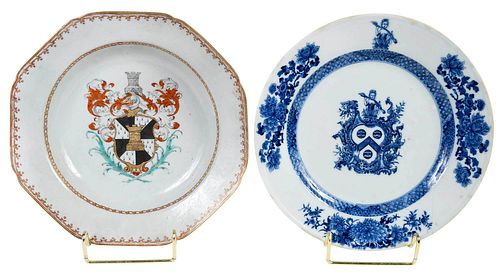Chinese Export Porcelain Armorial Soup and Plate, Hopper and Sykes
Bid Increments
| Price | Bid Increment |
|---|---|
| $0 | $25 |
| $100 | $50 |
| $1,000 | $100 |
| $2,000 | $200 |
| $3,000 | $250 |
| $5,000 | $500 |
| $10,000 | $1,000 |
| $20,000 | $2,000 |
| $50,000 | $5,000 |
| $100,000 | $10,000 |
comprising: soup plate, circa 1755, of octagonal form, centered with the arms of Hopper depicting eight part shield in black and white, centered with a tower, the whole surmounted with a helmet under a tower, scrolling gray and iron red leaves, two crossing green ferns beneath, gilt chain and decorative borders, gilt rim, 8-3/4 in.; circa 1755, plate in blue and white, centered with the arms of Sykes, central blue chevron between three fountains, the whole surmounted with demi triton issuing from reeds, blowing a shell, the whole surrounded with flowers and leaves, diaper border, rim with three floral sprays, the top with demi triton, 8-7/8 in.
Note: "One branch of the Hopper family lived at Shincliffe in Co. Durham at least since 1594. Hendry Hopper purchased in 1720 the estate of Crook Hall and the Manor of Sidgate. In 1739 he purchased, from Sir Thomas Robinson, the Lordship of Thrislington. He later bought Heugh Hall and Quarrington Grange, and died in 1752 without an heir.
His nephew, John of Shincliffe, succeeded and married in 1752 Elizabeth, daughter of Robert Hilton, and had three sons, of whom the second was Robert, Chancellor of the County Palatine of Durham and Recorder of Newcastle, who married Anne Williamson, granddaughter of Sir William Williamson, Bt., and from whom is descended the family of Hopper-Williamson."
Chinese Armorial Porcelain Volume I, David S. Howard, Faber & Faber, 31 May 1974, p. 421.
"This is one of two services made for the Sykes family about 1755 and while the other, impaling Hobman, was probably ordered through the Swedish East India Company, this was not. Richard Sykes, the elder of two sons born to Richard and his wife Mary Kirby of Sledmere, married firstly Elizabeth Hobman who died in 1750. It is possible that the service was made for his younger brother, the Revd. Sir Mark Sykes, who was created a baronet in 1783, but this seems less likely.
A detailed inventory was taken at Sledmore in January and February 1755, in which much china may be of this service, including three bowls, eighteen dishes, a soup dish, fifty-three dozen plates, and over fifty other pieces, and if this is so (the china is 'blue and white' but not listed as armorial) then this would coincide with many other great purchases for Sledmere, for it was Richard Sykes who extensively improved the house between 1750 and 1755."
Chinese Armorial Porcelain Volume I, David S. Howard, Faber & Faber, 31 May 1974, p. 583-84.
Provenance: Christopher M. Weld, Essex, Massachusetts
Condition
soup plate: spotting throughout, some discoloration, scratching, minor loss to paint and gilt decoration, fleabites to rim minor chipping to foot ring, anomalies as made, black light fluoresces to two spots on rim, indicating in-painting; plate: scratching, spotting, spot lacking glaze, rim break, hairline and chips filled, minor chipping to foot ring, label to base, blacklight fluoresces to majority of rim, indicating in-painting and hairline restorations
Purchased items will be available for pick up or shipping from our Asheville, North Carolina auction facility within ten business days of the auction will be assessed a storage fee of $5.00 per day, per item. Purchaser agrees that packing and shipping is done at the purchaser's risk and that the purchaser will pay in advance all packing expenses, materials, carrier fees and insurance charges. At our discretion, items will either be packed by an agent such as a packaging store or Brunk Auctions. Please allow two weeks for shipping after payment is received. Shipment of large items is the responsibility of the purchaser. We are happy to provide names of carriers and shippers if a purchaser so requests. Brunk Auctions will have no liability for any loss or damage to shipped items.












